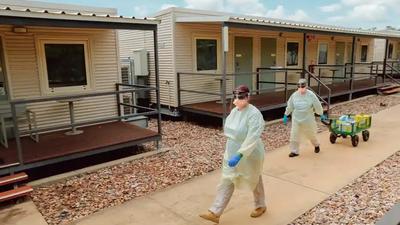
The Australian army has begun forcibly removing residents in the Northern Territories to the Howard Springs quarantine camp located in Darwin, after nine new Covid-19 cases were identified in the community of Binjari. The move comes after hard lockdowns were instituted in the communities of both Binjari and nearby Rockhole on Saturday night.

“Residents of Binjari and Rockhole no longer have the five reasons to leave their homes,” said Northern Territory chief minister, Michael Gunner, referring to the country’s five allowable reasons to avoid lockdown (buying food and supplies, exercising for up to two hours, care or caregiving, work or education if it can’t be done from home, and to get vaccinated at the nearest possible location).
“They can only leave for medical treatment, in an emergency, or as required by law.”
“It’s highly likely that more residents will be transferred to Howard Springs today, either as positive cases or close contacts,” he continued, adding “We have already identified 38 close contacts from Binjari but that number will go up. Those 38 are being transferred now.”
“I contacted the Prime Minister last night. We are grateful for the support of about 20 ADF personnel, as well as army trucks to assist with the transfer of positive cases and close contacts – and to support the communities.
Watch:
AUSTRALIA – The army is now transferring positive Covid cases and contacts in the Northern Territories to ‘Quarantine Camps’ by army truck.
So it wasn’t a conspiracy theory then. #COVID19 #Australia pic.twitter.com/NfJzqrO1fz
— Bernie's Tweets (@BernieSpofforth) November 22, 2021
“We’re conscious of the fact that this can have some impacts on people’s mental health as well as their general well being,” Police Commissioner Jamie Chalkner told NT News.
Of note, the Northern Territories are home to a large percentage of indigenous Australians. As the Epoch Times‘ Steve Milne notes:
According to the Australian Institute of Health and Welfare, in 2018-19, almost one in five Indigenous Australians lived in overcrowded dwellings (18 percent), compared to 5 percent of non-Indigenous Australians. Although this percentage had decreased from 27 percent in 2004, it still meant an estimated 145,340 Indigenous Australians were living in overcrowded dwellings in 2018-19.
In addition, the more remote an area, the higher the proportion of Indigenous Australians living in overcrowded dwellings (26 percent in remote areas and 51 percent in “very remote” areas), compared to 8 and 22 percent in non-remote areas.
Five days ago, NT Senator Malarndirri McCarthy told ABC that over crowding in Indigenous communities was a “massive problem,” pointing to the region’s second cluster of new infections – which included nine members of McCarthy’s direct family, including her sister who flew from Katherine to Robinson River while unknowingly bringing COVID-19 with her, per the report.
“If we could get housing in there right now, I would be pushing that straight away to the federal government and the NT government to work on that, but we obviously need the resources to do so,” she said.
Of the nine new cases in Binjari, four are women and five are men, including a 78-year-old woman who has been transported to Darwin Hospital.
There were zero new COVID-19 cases reported on Sunday, however Minister Gunner said he was worried about ‘mingling between households’ in Binjari and Rockhole, whose populations are around 220 and 130 respectively.
On Sunday, Gunner said: “Yes, these are strong measures, but the threat to lives is extreme.”
Nice people…
Via Zerohedge
